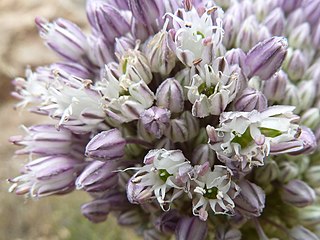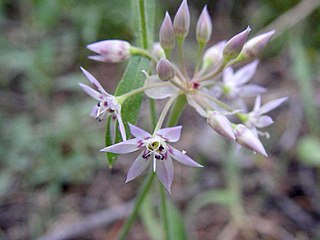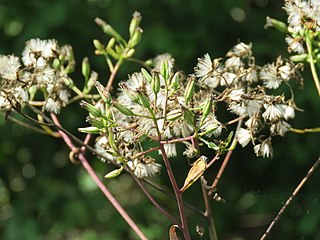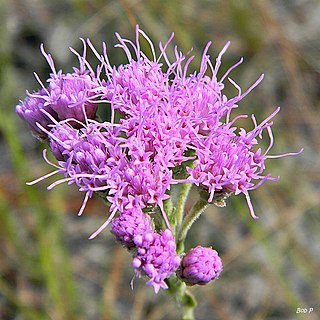
Allium tricoccum is a North American species of wild onion widespread across eastern Canada and the eastern United States. Many of the common English names for this plant are also used for other Allium species, particularly the similar Allium ursinum, which is native to Europe and Asia.

Allium ampeloprasum is a member of the onion genus Allium. The wild plant is commonly known as wild leek or broadleaf wild leek. Its native range is southern Europe to western Asia, but it is cultivated in many other places and has become naturalized in many countries.

Allium cernuum, known as nodding onion or lady's leek, is a perennial plant in the genus Allium. It grows in dry woods, rock outcroppings, and prairies. It has been reported from much of the United States, Canada and Mexico including in the Appalachian Mountains from Alabama to New York State, the Great Lakes Region, the Ohio and Tennessee River Valleys, the Ozarks of Arkansas and Missouri, and the Rocky and Cascade Mountains of the West, from Mexico to Washington. It has not been reported from California, Nevada, Florida, Louisiana, Mississippi, New Jersey, Delaware, New England, or much of the Great Plains. In Canada, it grows from Ontario to British Columbia.

Allium acuminatum, also known as the tapertip onion or Hooker's onion, is a species in the genus Allium native to North America.

Allium atrorubens is a species of wild onion known by the common name dark red onion. This plant is native to the southwestern United States where it grows in the sandy soils of the Mojave Desert, the Great Basin and higher-elevation deserts in Nevada, eastern California southwestern Utah, northwestern Arizona.

Allium campanulatum is a species of wild onion known by the common name dusky onion or Sierra onion. This is a flowering plant native to the western United States from southeastern Washington and northern Oregon to southern California, and western Nevada. The dusky onion grows in foothills and mountains, especially in dry areas, such as chaparral habitats.

Allium siskiyouense is a North American species of wild onion known by the common name Siskiyou onion. It is native to the Klamath Mountains and nearby ranges of northern California and Oregon. It grows in serpentine and other rocky soil types.

Allium stellatum, the autumn onion or prairie onion, is a North American species of wild onion native to central Canada and the central United States. It ranges from Ontario and Saskatchewan south to Tennessee and Texas.

Clintonia umbellulata, commonly known as white clintonia or speckled wood-lily, is a species of flowering plant in the lily family Liliaceae. The specific epithet umbellulata means "umbelled," which refers to the shape of the plant’s inflorescence.

Chelone obliqua, the red turtlehead, rose turtlehead or pink turtlehead, is a perennial flowering plant belonging to the family Plantaginaceae. This uncommon wildflower is endemic to the United States, where it is found in the Midwestern and southeastern states.

Allium macrum, the rock onion, is an American species of wild onion native to the eastern and central parts of the US States of Oregon and Washington. It grows on gravelly soils at elevations up to 1400 m. It is a perennial herb.

Allium douglasii, the Douglas onion, is a plant species native to northeastern Oregon, eastern Washington, and northern Idaho. It grows in shallow soils at elevations of 400–1,300 m (1,300–4,300 ft).
Smilax pumila, the sarsaparilla vine, is a North American species of plants native to the southeastern United States from eastern Texas to South Carolina.

Smilax maritima is a North American species of plants native to the south-eastern United States from Texas to North Carolina.

Arnoglossum ovatum, the ovateleaf cacalia, is a species of plant in the sunflower family. It is native to the southeastern and south-central United States from southern North Carolina to Florida and eastern Texas.

Arnoglossum reniforme, the great Indian plantain, is a North American species of plants in the sunflower family. It is native to the central and east-central United States primarily in the Appalachian Mountains, the Ohio/Tennessee Valley, and the Mississippi Valley. There are additional populations in the east and farther west in Oklahoma.

Bidens mitis, the smallfruit beggarticks, is a North American species of flowering plant in the family Asteraceae. It is native to the eastern, southeastern, and south-central parts of the United States, from eastern Texas to southern New Jersey.

Bradburia pilosa, the soft goldenaster, is a North American species of flowering plants in the family Asteraceae, native to the south-central United States, primarily the southeastern Great Plains and lower Mississippi Valley, in the states of Texas, Oklahoma, Kansas, Missouri, Arkansas, Louisiana, Tennessee, Mississippi, and Alabama. Additional populations are reported farther east but these appear to be introductions. Its habitats include disturbed roadsides and pine-oak-juniper woods.

Carphephorus corymbosus, the Florida paintbrush or coastal plain chaffhead, is a species of North American plants in the family Asteraceae. They are native to the southeastern United States in the States of Florida, Georgia, and South Carolina.
Chrysopsis gossypina, the cottony goldenaster, is a North American species of flowering plant in the family Asteraceae. It is native to the Coastal Plain of the southeastern United States, from eastern Louisiana to southeastern Virginia.

















